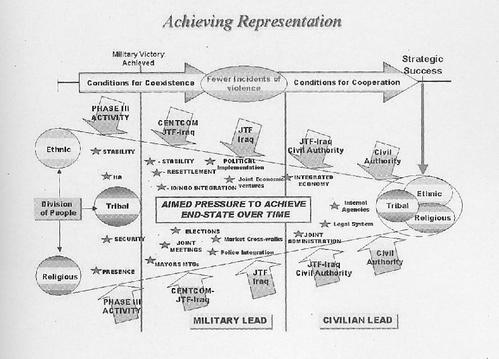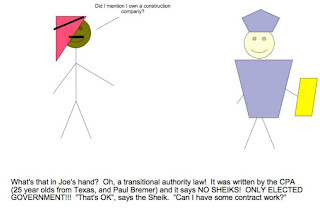Earlier this month, retired Marine Colonel TX Hammes
wrote an article in Armed Forces Journal regarding the drawbacks of pervasive PowerPoint use in the military. He challenged readers to compete in an essay contest at AFJ, with a selection of books as the prize.
Col. Hammes' article has gotten quite a reception throughout the blogosphere, with a few sites (Red Team Journal by Adam Elkus, Building Peace by "Reach 364", The Best Defense by Thomas Ricks) posting their own replies.
In the hopes of spurring some conversation on the topic--I'm too into the whole instant gratification thing to wait for the winner to be announced in November--I'm posting my own reply to Col. Hammes.
In January 2009, a military-oriented site, "Company Command", asked current Army commanders and platoon leaders in Iraq what they spent most of their time doing. One officer, Lt. Sam Nuxoll, answered flat-out: "Making PowerPoint slides".
When pressed, the lieutenant continued:
"I'm dead serious, guys. The one thing I spend more time on than anything else here in combat is making PowerPoint slides. I have to make a storyboard [a PowerPoint slide] complete with digital pictures, diagrams and text summaries on just about anything that happens. Recon a water pump? Make a storyboard. Conduct a key leader engagement? Make a storyboard. Award a microgrant? Make a
storyboard."
This generated a great deal of discussion from a number of junior officers in Iraq, who weighed in on the hours they put in each day making PowerPoint slides for mission briefings, storyboards, training meetings and command and staff meetings.
PowerPoint iseverywhere--not only in the military, but also in the government and private sector. Used correctly, it is an effective communication tool that can be used to supplement speeches or detailed, written operations orders. For example, an air assault mission involving dozens of aircraft, artillery and hundreds of troops can be collaboratively planned and briefed among the aviators and ground troops using maps, diagrams and satellite imagery e-mailed back and forth among the various actors on PowerPoint slides in order to assist the planning process. The graphics used in PowerPoint replace the massive campaign maps and problematic acetate overlays which were used by armies for decades, allowing these documents to be easily produced and mass-distributed with the click of a mouse. Indeed, PowerPoint has been the 21st Century's solution to the age-old requirement for organizations to report information between various levels of bureaucracy—whether it be a sales pitch to board members, or an air crew mission briefing for a flight of Black Hawk helicopters.
But PowerPoint is only as smart as those who are using it. In the military, business and even in NASA, misuse of PowerPoint can cause confusion and frustration. In the hands of a poor communicator, PowerPoint can spread misinformation, leading to bad decision-making. But we will also look at the flip side of the coin: despite the pervasiveness of elaborate PowerPoint presentations within the military, we will also look at PowerPoint presentations that would be considered poor by conventional standards, but actually communicated a message far more effectively than many other presentations.
There are two notable drawbacks of the use of PowerPoint (and other such slide-producing software) in most organizations. For starters, emphasis on style over substance causes a great deal of frustration—particularly as the process of making increasingly elaborate presentations takes time away from more important tasks. Secondly, the bullet-point format of PowerPoint often serves to oversimplify complex topics. Although the ability to display graphics allows the presenter to depict information such as a complex series of troop movements on a map, it can also be used to "dumb down" the audience, substituting cartoons for in-depth analysis.
Slides, transparencies and other charts have been in use in the military, the classroom, and in the board room for decades. Typically, they are used to provide a brief outline of subject material, or to provide some focal point of reference for everyone to look at, such as a map of an objective. These products were originally meant to supplement a lecture, briefing, or written order, not to be the central point of one. However, as time has gone on and PowerPoint has become more ubiquitous, presentations of this sort have, in some cases, become the sole focus of the briefing. Moreover, as the graphical capabilities of PowerPoint increased, so did the expectation to produce more graphically sophisticated presentations. What started as a simple medium for black text on white background quickly evolved into an extravaganza of unit or corporate logos and backgrounds and colorful charts. Unfortunately, as the graphical capabilities of PowerPoint increased, it also took a great deal more time to construct a presentation with the appropriate amount of "bells and whistles".
Star Wars director George Lucas once said, correctly, that "a special effect without a story is a pretty boring thing" (although, despite this advice, he still directed The Phantom Menace). Unfortunately, this piece of advice hasn't quite hit the circles of business, government or the military. In any of these fields, we find considerable emphasis being placed on adding more and more special effects to PowerPoint presentations. Stories abound in the military and business communities of PowerPoint presentations which are expected to look like elaborate Hollywood productions. Sales pitches may be filled with animation, elaborate motivational graphics and music. Military briefings may feature complex charts, or animated helicopters approaching and departing a landing zone and dropping off tiny Soldier icons.
Today, leaders in both business and the military may see dozens of PowerPoint briefings in a single day, and there is often competition to produce the most elaborate and extravagant PowerPoint presentation. Indeed, the process of spending hours each day adding more bells and whistles in PowerPoint presentations has become such an accepted part of military culture that many in the military use the term "PowerPoint Ranger", to describe someone who spends most of his or her time in front of a computer making PowerPoint slides. Some have even gone so far as to create mock badges, similar to the wings worn by paratroopers or aviators, which denote how many hours a person has logged in front of their computer on PowerPoint.
The respondents on CompanyCommand's site noted that, in some cases, time spent on PowerPoint cut into more important leader tasks, such as pre-combat inspections of equipment, mission rehearsals and interaction with Soldiers. While disseminating reports among units and headquarters has been an important part of military operations since armies communicated with signal flags and bugles, the key to effective communication is that reports are accurate, concise, and timely—that way, the message is understood, and subsequent decisions can be made based on the report. Ideally, timely, accurate and clear reporting helps to allow leaders at higher echelons in the military, government and in business to execute a far more efficient Observe-Orient-Decide-Act Loop, which is critical in any form of competition, from business to blitzkrieg.
Another issue brought up with the use of PowerPoint slides is the reliance on using cartoonish images to display complex information. The old adage holds true that a picture is worth a thousand words—indeed, complex troop movements can be better depicted on a moving map display than they can be through verbose operations orders. However, the flip side of the adage about a picture being worth a thousand words is that some issues are far too complex to be summed up in a thousand words.
Take "Phase IV" of Operation Iraqi Freedom, the reconstruction of Iraq. General Tommy Franks' headquarters produced a complicated-looking PowerPoint slide during the run-up to the invasion, which described the reconstruction of Iraq's services and government on the following PowerPoint slide.
Although the slide looks busy and complex, it's surprisingly sparse on the details of reconstructing an entire country after a massive invasion. (Although I need to caveat this by saying that this is not the only slide produced during the run-up to the invasion) Nevertheless, a slide like this, with nothing but pictures, arrows, lines and vague terms cannot accurately describe the process of turning a fractured dictatorship into a democracy.

Thomas Ricks, Pulitzer Prize-winning reporter and author of two books on the Iraq War, notes that the use of PowerPoint slides instead of written text permeated the US military during the run-up to the invasion of Iraq. Ricks noted in his book Fiasco, that General Tommy Franks' reliance on passing PowerPoint slides to his subordinates in order to plan the initial stages of the war, instead of explicit, written orders, caused much frustration among senior military officers. Ricks notes that military leaders such as General Robert McKiernan were often baffled as to how to interpret the slides. Ricks also interviewed Dr. Andrew Bacevich, who felt that substituting PowerPoint slides for formal, written orders was "the height of recklessness".
Over-reliance on PowerPoint's graphical features isn't the only aspect of viewgraph software that can cause miscommunication within the workplace. The "bullet-point" format of relaying information can also be a poor method of conveying complex information if used improperly. For example, in 2003, NASA engineers noted that a piece of material dislocated from the external fuel tank of the Space Shuttle Columbia, and struck the thermal-protective tile coating of the orbiter during its launch. Initial testing of the protective tile did not accurately reflect the fact that the Space Shuttle would be travelling several times the speed of sound. NASA engineers formed an emergency planning group, compiling a total of 28 slides, which documented the perceived extent of the damage to the Space Shuttle, as well as potential courses of action.
Dr. Edward Tufte of Yale University, an expert on information presentation who has participated in the accident investigation of both Space Shuttles, wrote extensively on the misuse of PowerPoint slides in NASA during the accident investigation board.
Tufte had considerable issues with one slide in particular, reproduced here.

The slide shows a huge contradiction between the title, in large font, and the actual text of the bullet-points, which is in small text. The title of the slide downplays the extent of the potential damage to the Space Shuttle ("indicates conservatism for tile penetration"), while the small text in the bullets however, indicate that the damage to the shuttle could potentially be significant, which it was ("Test results do show that [penetration and damage] is possible", "can cause significant damage", and "flight condition is significantly outside of test database"). Tufte notes that, as information was passed up the chain, important details were omitted—details which stressed the potential for extreme damage to the Columbia's wing, and ultimately, resulted in its destruction upon re-entry into Earth's atmosphere. Notes Tufte:
As information gets passed up an organization hierarchy, from people who do analysis to mid-level managers to high-level leadership, key explanations and supporting information is filtered out. In this context, it is easy to understand how a senior manager might read this PowerPoint slide and not realize that it addresses a life-threatening situation. At many points during its investigation, the Board was surprised to receive similar presentation slides from NASA officials in place of technical reports. The Board views the endemic use of PowerPoint briefing slides instead of technical papers as an illustration of the problematic methods of technical communication at NASA. [Emphasis added]
Despite the aforementioned examples of poor use of PowerPoint—namely, the oversimplification of text and graphics, and the emphasis on style over substance—there are some who have been able to communicate very effectively using the product, in some very surprising ways. One of the most famous PowerPoint presentations to come out of the Iraq War was made by the late Captain Travis Patriquin, a Special Forces Soldier who was serving in Anbar Province in Iraq during 2006. Patriquin played a part in developing some of the techniques which led to the success of "The Surge" of 2007—namely, the empowering of local sheiks and the development of local police forces and concerned local citizens groups, such as the Sons of Iraq.
Captain Patriquin produced an 18-slide PowerPoint presentation describing the effects of empowering the local population. In contrast with the extravagant animated presentations that are normally given in the military, Patriquin's features crudely-drawn stick figures (some of which are terrorists, who can be identified by the fact that they are holding decapitated stick figure heads), and uses language which parodies children's books. Patriquin features loads of tongue-in-cheek humor in the presentation as well; at one point noting that "Had we tried [arming concerned local citizens] earlier, Joe [the Soldier] would have a much more happy family, as he would have been home a lot more often". Patriquin also flings a smart-allecky remark at then-Ambassador Paul Bremer III, and the rest of the Coalition Provincial Authority regarding their disenfranchising of local sheiks.
The 18-slide presentation—looking for all the world like something out of a Jack Handey sketch—was distributed among a number  of senior officers. Despite the near-Hollywood production values which go into many PowerPoint presentations, it was this presentation which caught the attention of senior officers. The ideas presented by Captain Pataquin helped to change the course of the Iraq War. The format and look of Patriquin's message wasn't what counted—it was what he said. For all the satire and adolescent humor contained in his presentation, it presented a much clearer message about The Surge of 2007 than nearly any other document.
of senior officers. Despite the near-Hollywood production values which go into many PowerPoint presentations, it was this presentation which caught the attention of senior officers. The ideas presented by Captain Pataquin helped to change the course of the Iraq War. The format and look of Patriquin's message wasn't what counted—it was what he said. For all the satire and adolescent humor contained in his presentation, it presented a much clearer message about The Surge of 2007 than nearly any other document.
PowerPoint in and of itself is not to blame for communication failures in the workplace or military. As a reader in Dr. Edward Tufte's blog points out, blaming PowerPoint for the Columbia disaster would be like blaming Microsoft Outlook for spurring people to donate money to non-existant Nigerian royalty. Rather, our over-reliance on slide-view software, over-filtering of information, and over-simplification of complex ideas into small bullet points and cartoons is to blame for our communication errors. Not all presentations need be complex and filled with special effects, nor do important ideas need to be transmitted via PowerPoint. After all, our counterinsurgency manual, FM 3-24, was, in part, written based off of notes taken on a beer napkin at a hamburger restaurant.




 of senior officers. Despite the near-Hollywood production values which go into many PowerPoint presentations, it was this presentation which caught the attention of senior officers.
of senior officers. Despite the near-Hollywood production values which go into many PowerPoint presentations, it was this presentation which caught the attention of senior officers.